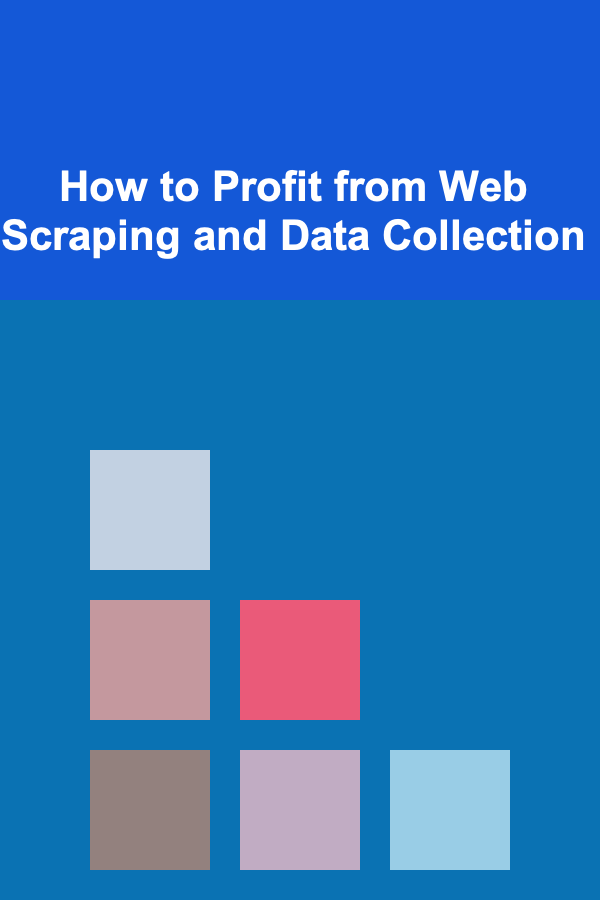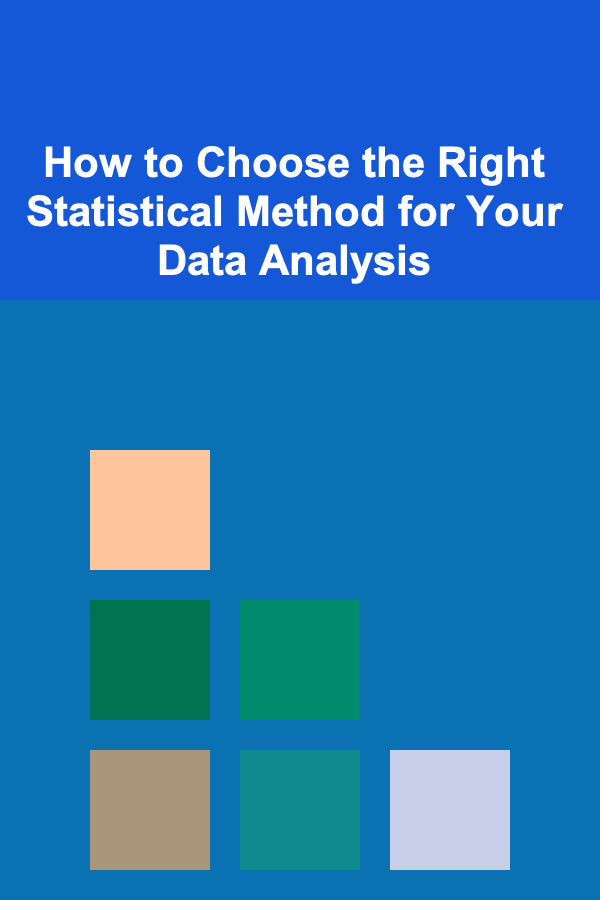
How to Profit from Web Scraping and Data Collection
ebook include PDF & Audio bundle (Micro Guide)
$12.99$7.99
Limited Time Offer! Order within the next:

Web scraping and data collection are becoming increasingly important tools for businesses and individuals looking to extract valuable information from the vast expanse of the internet. The digital world is rich with data, but not all of it is easy to access in a structured format. Web scraping allows for the extraction of data from websites, which can then be used for a variety of purposes, including competitive analysis, market research, lead generation, and more. This article will explore how you can profit from web scraping and data collection, delving into the tools, techniques, legal considerations, and business applications.
What is Web Scraping?
Web scraping, also known as web harvesting or web data extraction, is the process of using a bot or software to extract data from websites. Unlike manually copying and pasting information, web scraping automates the process and allows you to gather large amounts of data quickly. The data can come in various forms, such as text, images, or links, and can be collected from a single webpage or across multiple websites.
At its core, web scraping is about converting unstructured data (data that is not organized) into structured data (data that is organized and can be easily analyzed). This can be done using web scraping tools or writing custom scripts in programming languages like Python, which allow users to interact with web pages, extract the desired information, and store it for further use.
The Potential of Data Collection for Profit
The true value of web scraping lies in its ability to collect large amounts of data that can be used to drive business decisions, optimize marketing strategies, and even generate revenue. Below are some of the ways that individuals and businesses can profit from web scraping and data collection.
1. Competitive Analysis
Businesses are constantly striving to stay ahead of their competitors. Web scraping can provide valuable insights into competitors' pricing strategies, product offerings, customer sentiment, and marketing tactics. By scraping data from competitor websites, businesses can monitor changes in product pricing, inventory, customer reviews, and promotions in real time.
This information can then be used to adjust pricing strategies, develop better products, and identify areas for improvement. For example, e-commerce businesses can scrape product listings from competitors to compare prices and adjust their own offerings to remain competitive in the market.
2. Market Research
Market research is essential for any business looking to understand consumer preferences, trends, and emerging market opportunities. Web scraping allows businesses to gather large datasets from various sources, including news websites, social media platforms, forums, and blogs. This data can provide insights into customer behavior, market demand, and trends that would be difficult to track manually.
By collecting data on customer reviews, comments, and social media conversations, businesses can identify pain points, areas for innovation, and what customers are truly looking for. Web scraping also allows businesses to keep tabs on changes in public opinion, which can be particularly useful for product development and branding.
3. Lead Generation
Lead generation is the process of identifying potential customers for your product or service. With web scraping, businesses can collect contact information, such as email addresses, phone numbers, and social media profiles, from a variety of websites, including business directories, job boards, and social media platforms. This can be an excellent way to build a list of qualified leads for your marketing campaigns.
Scraping job listing websites, for example, can help you identify businesses that are hiring and may need your product or service. Similarly, scraping real estate websites can provide contact information for individuals who are interested in buying or selling properties. By using web scraping for lead generation, businesses can reduce the time and effort spent on prospecting and increase their sales efficiency.
4. Sentiment Analysis
Sentiment analysis is the process of analyzing the opinions and emotions expressed in text data. By scraping social media, online reviews, and forums, businesses can track public sentiment about their brand, products, and services. This can be invaluable for understanding customer satisfaction, detecting potential issues, and improving customer engagement.
For example, web scraping can allow businesses to track mentions of their brand or product on Twitter, Facebook, Reddit, and other platforms. By analyzing these mentions, businesses can identify patterns in consumer sentiment, respond to negative feedback, and capitalize on positive reviews. Sentiment analysis can also be used to monitor competitors and their customer feedback, providing an additional layer of market intelligence.
5. Content Aggregation
Another profitable application of web scraping is content aggregation. Many businesses and individuals collect content from various sources to create curated lists, news aggregators, or comparison websites. This can include articles, blog posts, product listings, or even videos. By scraping content from multiple websites, you can create a platform that provides users with valuable information or comparisons in one place.
For example, comparison websites for products, services, or even travel destinations rely heavily on data collected through web scraping. Content aggregators, such as news websites or blog directories, also use scraping techniques to pull in articles and posts from multiple sources. These platforms can be monetized through ads, affiliate marketing, or subscription models.
6. Real-Time Data Monitoring
Real-time data monitoring is crucial in industries like finance, e-commerce, and logistics. With web scraping, you can monitor live data such as stock prices, exchange rates, shipping statuses, or even sports scores. This data can be used for decision-making, predictions, and real-time alerts.
For example, investors may use web scraping to collect data from stock market websites and track real-time changes in stock prices. E-commerce businesses can scrape competitor websites to monitor their product availability and adjust their inventory accordingly. Similarly, logistics companies can scrape shipping provider websites to track real-time shipping status and optimize delivery routes.
7. Selling Data to Third Parties
In some cases, businesses or individuals can collect and sell data to third parties for profit. Data brokers buy and sell data to companies that need it for various purposes, including marketing, advertising, and analytics. If you can collect valuable datasets through web scraping, you may be able to sell this data to companies in need of it.
For example, if you scrape data on real estate listings, businesses in the real estate sector may be interested in purchasing the data for analysis or targeted advertising. Similarly, scraping job boards and selling that data to recruitment agencies could be a profitable venture. However, selling data comes with ethical and legal considerations, which will be discussed later in this article.
Tools and Techniques for Web Scraping
Web scraping can be done using various tools and techniques. The choice of tool depends on the scale of the scraping project, the complexity of the websites being scraped, and the type of data you wish to collect.
1. Web Scraping Tools
There are many web scraping tools available, each catering to different levels of expertise and use cases. Some of the popular web scraping tools include:
- BeautifulSoup: A Python library used for parsing HTML and XML documents. BeautifulSoup is ideal for beginners and is easy to use for simple scraping tasks.
- Scrapy: A Python-based web scraping framework that provides powerful tools for crawling and scraping websites. Scrapy is ideal for more complex projects that require handling multiple pages or dealing with dynamic content.
- Selenium: A web automation tool that allows you to control web browsers programmatically. Selenium is useful for scraping dynamic websites that rely heavily on JavaScript to load content.
- Octoparse: A visual web scraping tool that does not require programming knowledge. Octoparse is user-friendly and can be used for scraping a variety of websites.
2. Custom Scripts
For more flexibility and control, many experienced web scrapers write custom scripts using programming languages like Python, Ruby, or Node.js. These scripts can interact with websites, extract the desired data, and save it in a structured format like CSV, JSON, or a database.
Custom scripts offer more control over the scraping process, such as handling pagination, logging in to websites, or interacting with JavaScript-rendered content. Python is one of the most popular languages for web scraping due to its simplicity and extensive libraries.
3. Cloud-Based Scraping
Cloud-based scraping solutions allow you to scale your scraping efforts without worrying about hardware limitations. These solutions often offer a set of tools and services that automate the process of scraping, including proxies, IP rotation, and anti-captcha mechanisms. Popular cloud-based scraping services include:
- Scrapinghub: A cloud-based platform that provides powerful scraping tools and proxy management. Scrapinghub is ideal for large-scale scraping projects.
- DataMiner: A cloud-based web scraping tool that allows users to create scraping recipes and export data to various formats.
Legal and Ethical Considerations
While web scraping can be a powerful tool for gathering data, it is essential to be aware of the legal and ethical implications. Scraping data from websites without permission can lead to legal action, particularly if the data is copyrighted or the scraping activity violates the website's terms of service.
1. Terms of Service Violations
Most websites have terms of service (TOS) that govern how users can interact with their content. Many websites explicitly prohibit scraping or automated access to their data. Violating these terms of service can result in the website blocking your IP address or taking legal action against you.
Before scraping a website, it is important to review its TOS to ensure that you are not violating any rules. If in doubt, consider reaching out to the website owner for permission to scrape their data.
2. Copyright and Data Ownership
Another legal consideration is the ownership of the data you are scraping. Some websites may own the copyright to the data on their site, and scraping that data could be considered an infringement. Be cautious about scraping and selling copyrighted content, as this can lead to legal consequences.
3. Privacy and Personal Data Protection
Web scraping can also raise privacy concerns, particularly when scraping personal data such as contact information or social media profiles. Many countries have strict data privacy laws, such as the General Data Protection Regulation (GDPR) in the European Union, which regulate how personal data can be collected, stored, and used.
Ensure that your web scraping activities comply with data privacy laws and that you are not scraping sensitive personal data without proper consent.
Conclusion
Web scraping and data collection offer numerous opportunities for businesses and individuals to profit from valuable insights and data. By automating the process of gathering information from the web, you can conduct competitive analysis, market research, lead generation, and more. However, it is essential to approach web scraping ethically and legally, ensuring that you are not violating terms of service, copyright laws, or privacy regulations. By leveraging the right tools and techniques, you can turn web scraping into a profitable venture that drives business success and informs better decision-making.
Reading More From Our Other Websites
- [Organization Tip 101] How to Sort and Declutter Toys Regularly
- [Organization Tip 101] How to Create a Shared Hobby Corner
- [Home Pet Care 101] How to Make Your Home Safe for Pet Birds
- [Organization Tip 101] How to Use Shelving for Stylish Living Room Organization
- [Small Business 101] How to Leverage Social Media Marketing for Small Business Success
- [Home Renovating 101] How to Choose the Perfect Color Palette for Your Home
- [Home Budget Decorating 101] How to Create a Focal Point in Your Home on a Budget
- [Organization Tip 101] How to Choose the Best Solar Garden Lights for Your Outdoor Space
- [Paragliding Tip 101] Thermals, Ridge Lift, and Turbulence: Decoding Weather Factors for Safe Flights
- [Home Lighting 101] How to Achieve Flawless Makeup with Vanity Lighting: A Step-by-Step Guide

How to Build a Checklist for Researching Content Ideas
Read More
How to Organize and Store Craft Supplies Efficiently
Read More
How to Profit from Deep Learning Models in the Freelance World
Read More
How to Master Salary Negotiation for New Roles
Read More
Improving Speed and Agility: A Comprehensive Guide
Read More
How to Choose the Right Statistical Method for Your Data Analysis
Read MoreOther Products

How to Build a Checklist for Researching Content Ideas
Read More
How to Organize and Store Craft Supplies Efficiently
Read More
How to Profit from Deep Learning Models in the Freelance World
Read More
How to Master Salary Negotiation for New Roles
Read More
Improving Speed and Agility: A Comprehensive Guide
Read More